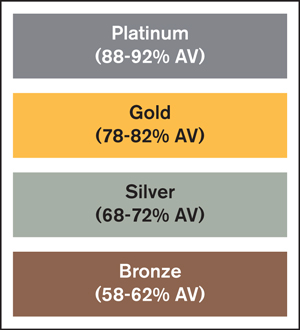Understanding Standardized Health Care Products Under the Affordable Care Act
May 2013 – One of the objectives of the Affordable Care Act (ACA) is to standardize products in the individual and small employer markets through “Metal Levels.” Four metal levels will determine the type of health insurance that can be offered to individuals and small employers: Platinum, Gold, Silver and Bronze.
Additionally, the ACA outlines the percent of health care expenses that each metal level plan design would typically expect to pay for essential health care benefits. This is called the health plan’s “Actuarial Value.” For example, a health plan with a 70 percent actuarial value would on average pay 70 percent of expenses for essential health benefits with the enrollee paying 30 percent through a combination of co-pays, deductibles and co-insurance.
 The four metal levels are defined by actuarial value targets that a qualified health plan must achieve, plus or minus 2 percent. For example, a silver plan must have an actuarial value of 68 percent to 72 percent.
The four metal levels are defined by actuarial value targets that a qualified health plan must achieve, plus or minus 2 percent. For example, a silver plan must have an actuarial value of 68 percent to 72 percent.
In addition to the four metal level plans, “Catastrophic” plans are allowed in the individual health care market for young adults (under age 30).
Most health insurance insurers will offer benefits designs at all four of the metal levels. Insurers must offer at least one Silver and one Gold plan design if they are offering products on the federal or state marketplace (exchange).


Leave a Reply
Want to join the discussion?Feel free to contribute!